Assessment of Spatial-Temporal Changes of Landscape Ecological Risk in Xishuangbanna, China from 1990 to 2019
Abstract
:1. Introduction
2. Materials and methods
2.1. Study Area
2.2. Data Sources
2.3. Methodology
2.3.1. Land Use/Land Cover Transfer Matrix
2.3.2. Construction of Landscape Ecological Risk Evaluation Model
Determine the Risk Evaluation Cell
Construction of Landscape Ecological Risk Index (ERI)
2.3.3. Spatial Autocorrelation Analysis Methods
3. Results
3.1. Dynamic Change of LULC from 1990 to 2019
3.2. Spatial-Temporal Changes of Landscape Ecological Risk from 1990 to 2019
3.3. Spatial Autocorrelation Analysis of Landscape Ecological Risk
4. Discussion
4.1. The Effect of LULC on Landscape Ecological Risk
4.2. Strengths and Limitations
5. Conclusions
Author Contributions
Funding
Acknowledgments
Conflicts of Interest
References
- Cheng, D. The practice of Global Ecological Civilization Construction in China. Hunan Soc. Sci. 2022, 109–116. Available online: https://kns.cnki.net/kcms/detail/43.1161.C.20220418.1208.030.html (accessed on 18 April 2022).
- Long, Y.; Mei, M. Land use dynamic change analysis of Xishuangbanna based on Landsat ETM/OLI. Agrotech. Serv. 2017, 34, 123–124. [Google Scholar]
- Li, J.; Yang, X.; Zhang, Z.; Li, T.; Lang, X.; Ma, Y. Analysis of Land Use in Xishuangbanna in Recent 20 Years. Value Eng. 2019, 38, 219–222. [Google Scholar]
- Cao, H.; Liu, J.; Fu, C.; Zhang, W.; Wang, G.; Yang, G.; Luo, L. Urban Expansion and Its Impact on the Land Use Pattern in Xishuangbanna since the Reform and Opening up of China. Remote Sens. 2017, 9, 137. [Google Scholar] [CrossRef]
- Hu, H.; Liu, W.; Cao, M. Impact of land use and land cover changes on ecosystem services in Menglun, Xishuangbanna, Southwest China. Environ. Monit. Assess. 2007, 146, 147–156. [Google Scholar] [CrossRef] [PubMed]
- Fan, J.; Wang, Y.; Zhou, Z.; You, N.; Meng, J. Dynamic Ecological Risk Assessment and Management of Land Use in the Middle Reaches of the Heihe River Based on Landscape Patterns and Spatial Statistics. Sustainability 2016, 8, 536. [Google Scholar] [CrossRef]
- Xu, W.; Huang, S.; Wu, C.; Xiong, Y.; Wang, L.; Lu, N.; Kou, W. The pruning phenological phase-based method for extracting tea plantations by field hyperspectral data and Landsat time series imagery. Geocarto Int. 2020, 37, 2116–2136. [Google Scholar] [CrossRef]
- Liu, J.; Du, M.; Mao, Z. Scale computation on high spatial resolution remotely sensed imagery multi-scale segmentation. Int. J. Remote Sens. 2017, 38, 5186–5214. [Google Scholar] [CrossRef]
- Ji, Y.; Bai, Z.; Hui, J. Landscape Ecological Risk Assessment Based on LUCC—A Case Study of Chaoyang County, China. Forests 2021, 12, 1157. [Google Scholar] [CrossRef]
- Ai, J.; Yu, K.; Zeng, Z.; Yang, L.; Liu, Y.; Liu, J. Assessing the dynamic landscape ecological risk and its driving forces in an island city based on optimal spatial scales: Haitan Island, China. Ecol. Indic. 2022, 137, 108771. [Google Scholar] [CrossRef]
- Jin, X.; Jin, Y.; Mao, X. Ecological risk assessment of cities on the Tibetan Plateau based on land use/land cover changes—Case study of Delingha City. Ecol. Indic. 2019, 101, 185–191. [Google Scholar] [CrossRef]
- Xiong, Y.; Xu, W.; Huang, S.; Wu, C.; Dai, F.; Wang, L.; Lu, N.; Kou, W. Ecological environment quality assessment of Xishuangbanna rubber plantations expansion (1995–2018) based on multi-temporal Landsat imagery and RSEI. Geocarto Int. 2022, 37, 3441–3468. [Google Scholar] [CrossRef]
- Liu, J.; Wang, M.; Yang, L. Assessing Landscape Ecological Risk Induced by Land-Use/Cover Change in a County in China: A GIS- and Landscape-Metric-Based Approach. Sustainability 2020, 12, 9037. [Google Scholar] [CrossRef]
- Zhang, F.; Yushanjiang, A.; Wang, D. Ecological risk assessment due to land use/cover changes (LUCC) in Jinghe County, Xinjiang, China from 1990 to 2014 based on landscape patterns and spatial statistics. Environ. Earth Sci. 2018, 77, 491. [Google Scholar] [CrossRef]
- Wang, H.; Liu, X.; Zhao, C.; Chang, Y.; Liu, Y.; Zang, F. Spatial-temporal pattern analysis of landscape ecological risk assessment based on land use/land cover change in Baishuijiang National nature reserve in Gansu Province, China. Ecol. Indic. 2021, 124, 107454. [Google Scholar] [CrossRef]
- Lu, L.; Zhang, J.; Sun, C. Landscape ecological risk assessment of Xihe River Basin based on land use change. Chin. J. Ecol. 2018, 38, 5952–5960. [Google Scholar]
- Zang, S.; Liang, X.; Zhang, S.C. GIS-based analysis of ecological risk on land-use in Daqing City. J. Nat. Disasters 2005, 14, 141. [Google Scholar]
- Li, C.; Chen, J.; Liao, M.; Chen, G.; Zhou, Q. Ecological Risk Assessment of Shan Xin Mining Area Based on Remote Sensing and Geography Information System Technology. J. Geogr. Inf. Syst. 2018, 10, 234–246. [Google Scholar] [CrossRef]
- Beanlands, G.E.; Duinker, P.N. An ecological Framework for Environmental Impact Assessment in Canada; Institute for Resource and Environmental Studies, Dalhousie University: Halifax, NS, Canada, 1983. [Google Scholar]
- Wang, M.; Bai, Y.; Chen, W.; Markert, B.; Peng, C.; Ouyang, Z. A GIS technology based potential eco-risk assessment of metals in urban soils in Beijing, China. Environ. Pollut. 2012, 161, 235–242. [Google Scholar] [CrossRef] [PubMed]
- Hou, M.; Ge, J.; Gao, J.; Meng, B.; Li, Y.; Yin, J.; Liu, J.; Feng, Q.; Liang, T. Ecological Risk Assessment and Impact Factor Analysis of Alpine Wetland Ecosystem Based on LUCC and Boosted Regression Tree on the Zoige Plateau, China. Remote Sens. 2020, 12, 368. [Google Scholar] [CrossRef]
- Qian, Y.; Dong, Z.; Yan, Y.; Tang, L. Ecological risk assessment models for simulating impacts of land use and landscape pattern on ecosystem services. Sci. Total Environ. 2022, 833, 155218. [Google Scholar] [CrossRef] [PubMed]
- Cui, L.; Zhao, Y.; Liu, J.; Han, L.; Ao, Y.; Yin, S. Landscape ecological risk assessment in Qinling Mountain. Geol. J. 2018, 53, 342–351. [Google Scholar] [CrossRef]
- Dale, V.H.; Kline, K.L. Issues in using landscape indicators to assess land changes. Ecol. Indic. 2013, 28, 91–99. [Google Scholar] [CrossRef]
- Salvati, L.; Zitti, M. Assessing the impact of ecological and economic factors on land degradation vulnerability through multiway analysis. Ecol. Indic. 2009, 9, 357–363. [Google Scholar] [CrossRef]
- Xiong, Y.; Xu, W.; Lu, N.; Huang, S.; Wu, C.; Wang, L.; Dai, F.; Kou, W. Assessment of spatial–temporal changes of ecological environment quality based on RSEI and GEE: A case study in Erhai Lake Basin, Yunnan province, China. Ecol. Indic. 2021, 125, 107518. [Google Scholar] [CrossRef]
- Lin, L.; Zhang, L.; Feng, L.; Guo, X.; Zhao, J.; Dao, J. A preliminary study on designing ecological corridors in Xishuangbanna National Nature Reserve with 3S techniques. Front. Biol. China 2008, 3, 101–105. [Google Scholar] [CrossRef]
- Gong, J.; Yang, J.; Tang, W. Spatially Explicit Landscape-Level Ecological Risks Induced by Land Use and Land Cover Change in a National Ecologically Representative Region in China. Int. J. Environ. Res. Public Health 2015, 12, 14192–14215. [Google Scholar] [CrossRef] [PubMed]
- Ju, H.; Niu, C.; Zhang, S.; Jiang, W.; Zhang, Z.; Zhang, X.; Yang, Z.; Cui, Y. Spatiotemporal patterns and modifiable areal unit problems of the landscape ecological risk in coastal areas: A case study of the Shandong Peninsula, China. J. Clean. Prod. 2021, 310, 127522. [Google Scholar] [CrossRef]
- Fan, G.; Cowley, J. Auto-correlation analysis of high resolution electron micrographs of near-amorphous thin films. Ultramicroscopy 1985, 17, 345–355. [Google Scholar] [CrossRef]
- Anselin, L. Local Indicators of Spatial Association—LISA. Geogr. Anal. 1995, 27, 93–115. [Google Scholar] [CrossRef]
- Bi, Y.; Ma, J.; Li, S. Landscape Patterns of Wetland Parks in Suzhou based on ArcGIS and Fragstats: A Case Study of Huqiu Wetland Park and Taihu Hubin National Wetland Park. IOP Conf. Ser. Earth Environ. Sci. 2021, 668, 012004. [Google Scholar] [CrossRef]
- Amani, M.; Ghorbanian, A.; Ahmadi, S.A.; Kakooei, M.; Moghimi, A.; Mirmazloumi, S.M.; Moghaddam, S.H.A.; Mahdavi, S.; Ghahremanloo, M.; Parsian, S.; et al. Google Earth Engine Cloud Computing Platform for Remote Sensing Big Data Applications: A Comprehensive Review. IEEE J. Sel. Top. Appl. Earth Obs. Remote Sens. 2020, 13, 5326–5350. [Google Scholar] [CrossRef]
- Tamiminia, H.; Salehi, B.; Mahdianpari, M.; Quackenbush, L.; Adeli, S.; Brisco, B. Google Earth Engine for geo-big data applications: A meta-analysis and systematic review. ISPRS J. Photogramm. Remote Sens. 2020, 164, 152–170. [Google Scholar] [CrossRef]
- Li, Q.; Qiu, C.; Ma, L.; Schmitt, M.; Zhu, X.X. Mapping the Land Cover of Africa at 10 m Resolution from Multi-Source Remote Sensing Data with Google Earth Engine. Remote Sens. 2020, 12, 602. [Google Scholar] [CrossRef]
- Jia, H.; Yan, C.; Xing, X. Evaluation of Eco-Environmental Quality in Qaidam Basin Based on the Ecological Index (MRSEI) and GEE. Remote Sens. 2021, 13, 4543. [Google Scholar] [CrossRef]
- Gorelick, N.; Hancher, M.; Dixon, M.; Ilyushchenko, S.; Thau, D.; Moore, R. Google Earth Engine: Planetary-scale geospatial analysis for everyone. Remote Sens. Environ. 2017, 202, 18–27. [Google Scholar] [CrossRef]
- Kumar, L.; Mutanga, O. Google Earth Engine Applications Since Inception: Usage, Trends, and Potential. Remote Sens. 2018, 10, 1509. [Google Scholar] [CrossRef]
- Li, H.; Ma, Y.; Aide, T.M.; Liu, W. Past, present and future land-use in Xishuangbanna, China and the implications for carbon dynamics. For. Ecol. Manag. 2008, 255, 16–24. [Google Scholar] [CrossRef]
- Sarathchandra, C.; Abebe, Y.A.; Worthy, F.R.; Wijerathne, I.L.; Ma, H.; Yingfeng, B.; Jiayu, G.; Chen, H.; Yan, Q.; Geng, Y.; et al. Impact of land use and land cover changes on carbon storage in rubber dominated tropical Xishuangbanna, South West China. Ecosyst. Health Sustain. 2021, 7, 1915183. [Google Scholar] [CrossRef]
- Liu, S.; Deng, L.; Dong, S.; Zhao, Q.; Yang, J.; Wang, C. Landscape connectivity dynamics based on network analysis in the Xishuangbanna Nature Reserve, China. Acta Oecologica 2014, 55, 66–77. [Google Scholar] [CrossRef]
- Li, H.; Aide, T.M.; Ma, Y.; Liu, W.; Cao, M. Demand for rubber is causing the loss of high diversity rain forest in SW China. In Plant Conservation and Biodiversity; Springer: Dordrecht, The Netherlands, 2006; pp. 157–171. [Google Scholar]
- Yang, J.; Huang, X. The 30 m annual land cover dataset and its dynamics in China from 1990 to 2019. Earth Syst. Sci. Data 2021, 13, 3907–3925. [Google Scholar] [CrossRef]
- Gong, P.; Wang, J.; Yu, L.; Zhao, Y.; Zhao, Y.; Liang, L.; Niu, Z.; Huang, X.; Fu, H.; Liu, S.; et al. Finer resolution observation and monitoring of global land cover: First mapping results with Landsat TM and ETM+ data. Int. J. Remote Sens. 2013, 34, 2607–2654. [Google Scholar] [CrossRef]
- Zhu, H.; Li, X. Discussion on the index method of regional land use change. Acta Geogr. Sin. 2003, 58, 643–650. [Google Scholar]
- Xiao, F.; Ouyang, H.; Cheng, S.; Zhang, Q. Forest health ecological risk assessment in China. Ying Yong Sheng Tai Xue Bao=J. Appl. Ecol. 2004, 15, 349–353. [Google Scholar]
- Zhang, W.; Chang, W.J.; Zhu, Z.C.; Hui, Z. Landscape ecological risk assessment of Chinese coastal cities based on land use change. Appl. Geogr. 2020, 117, 102174. [Google Scholar] [CrossRef]
- Lin, J.; Duo, L.; Zuo, Z. Dynamic Evolution and Spatial Autocorrelation Analysis of Landscape Fragmentation under the Background of Urban Expansion-A Case Study of Nan chang City. Res. Soil Water Conserv. 2022, 1–8. Available online: https://kns.cnki.net/kcms/detail/61.1272.P.20220413.1717.012.html (accessed on 13 April 2022).
- Yu, T.; Bao, A.; Xu, W.; Guo, H.; Jiang, L.; Zheng, G.; Yuan, Y.; Nzabarinda, V. Exploring Variability in Landscape Ecological Risk and Quantifying Its Driving Factors in the Amu Darya Delta. Int. J. Environ. Res. Public Health 2020, 17, 79. [Google Scholar] [CrossRef]
- Xu, W.; Qin, Y.; Xiao, X.; Di, G.; Doughty, R.B.; Zhou, Y.; Zou, Z.; Kong, L.; Niu, Q.; Kou, W. Quantifying spatial-temporal changes of tea plantations in complex landscapes through integrative analyses of optical and microwave imagery. Int. J. Appl. Earth Obs. Geoinf. ITC J. 2018, 73, 697–711. [Google Scholar] [CrossRef]
- Liu, X.; Feng, Z.; Jiang, L.; Zhang, J. Spatial-Temporal Pattern Analysis of Land Use and Land Cover Change in Xishuangbanna. Resour. Sci. 2014, 36, 233–244. [Google Scholar]
- Wu, X.; Duan, H.; Yang, J. Discussion on the protection and restoration of tropical rainforest in Xishuangbanna. Environ. Sustain. Dev. 2020, 45, 118–121. [Google Scholar]
- A Hanifah, N.; Shah, R.M.; Hashim, R. Impact of Human Activities in Antarctica: Dissecting the Concepts of Ecologically Sustainable Development and Natural Reserve for Peace and Science. APCBEE Procedia 2012, 1, 177–181. [Google Scholar] [CrossRef]
- Zhao, X. An analysis of the change of the population of the nationalitise in XiShuangBanNa Autonomous State. Northwest Popul. 2003, 59–61, 65. Available online: https://kns.cnki.net/kcms/detail/detail.aspx?FileName=XBRK200303017&DbName=CJFQ2003 (accessed on 13 April 2022).
- Guo, H.; Wang, B.; Niu, X. Construction Method of Ecological Benefits Monitoring Network of China Grain for Green Project. Bull. Soil Water Conserv. 2014, 34, 131–133. [Google Scholar]
- Peng, J.; Zong, M.; Hu, Y.; Liu, Y.; Wu, J. Assessing Landscape Ecological Risk in a Mining City: A Case Study in Liaoyuan City, China. Sustainability 2015, 7, 8312–8334. [Google Scholar] [CrossRef] [Green Version]

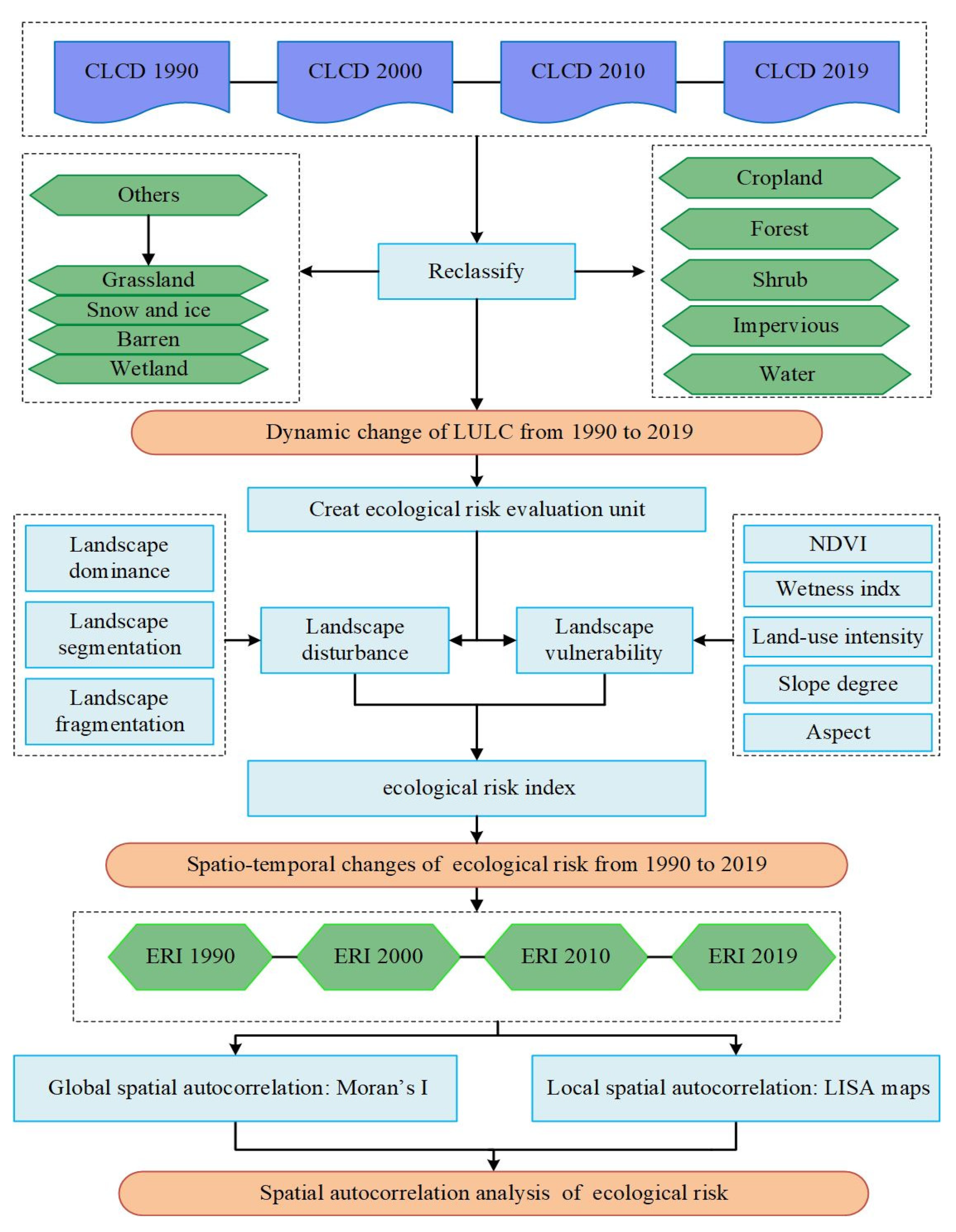
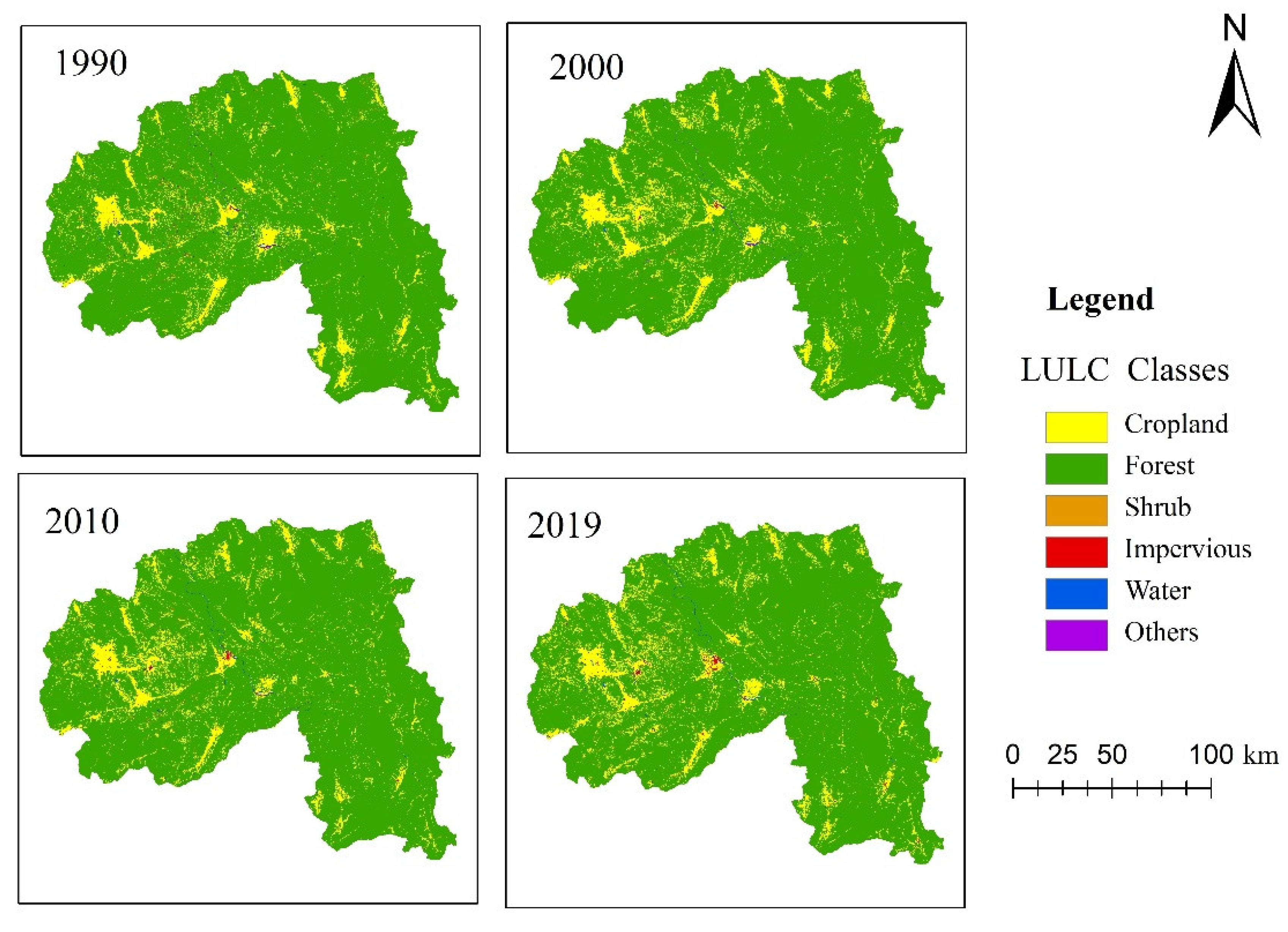
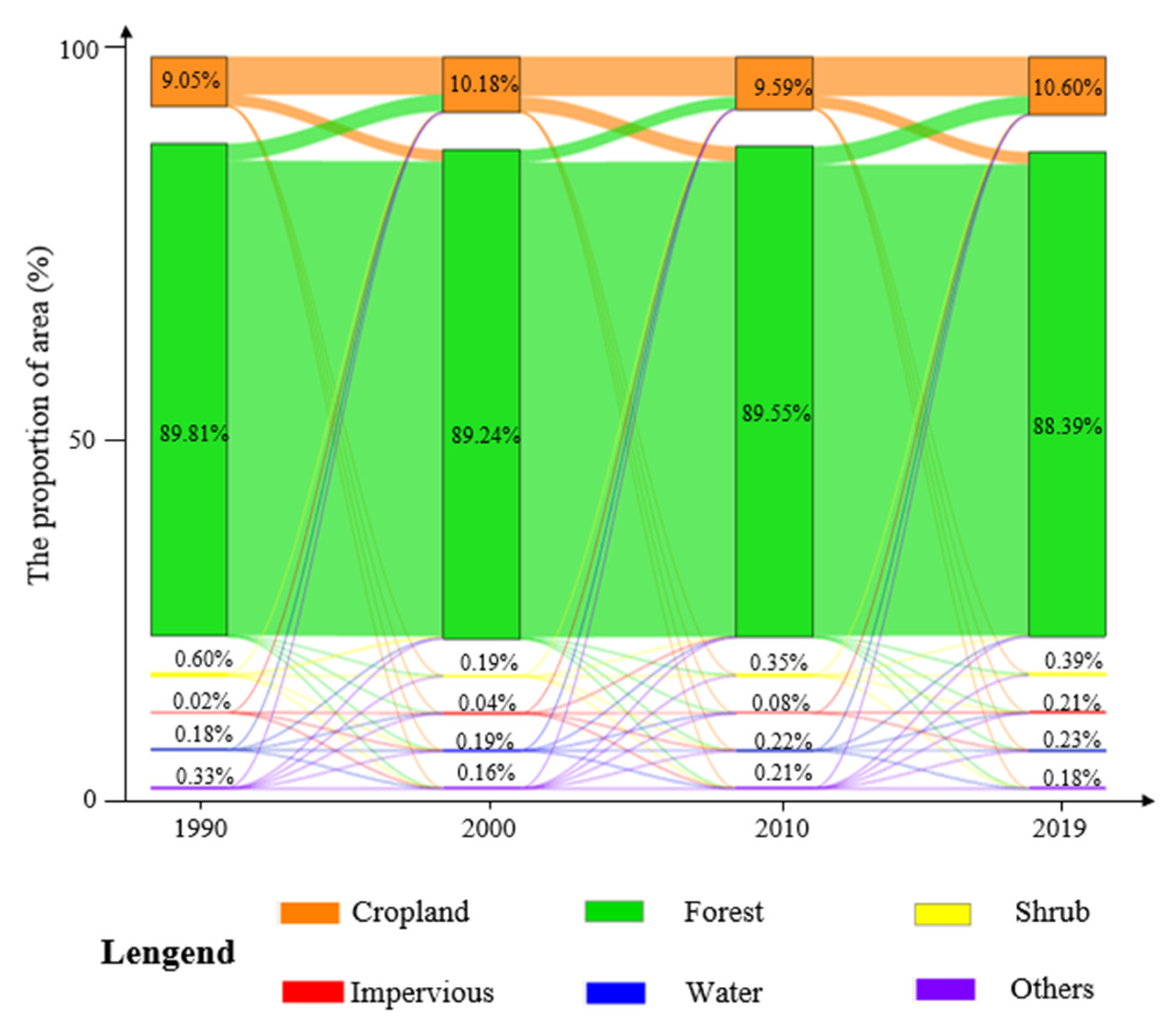
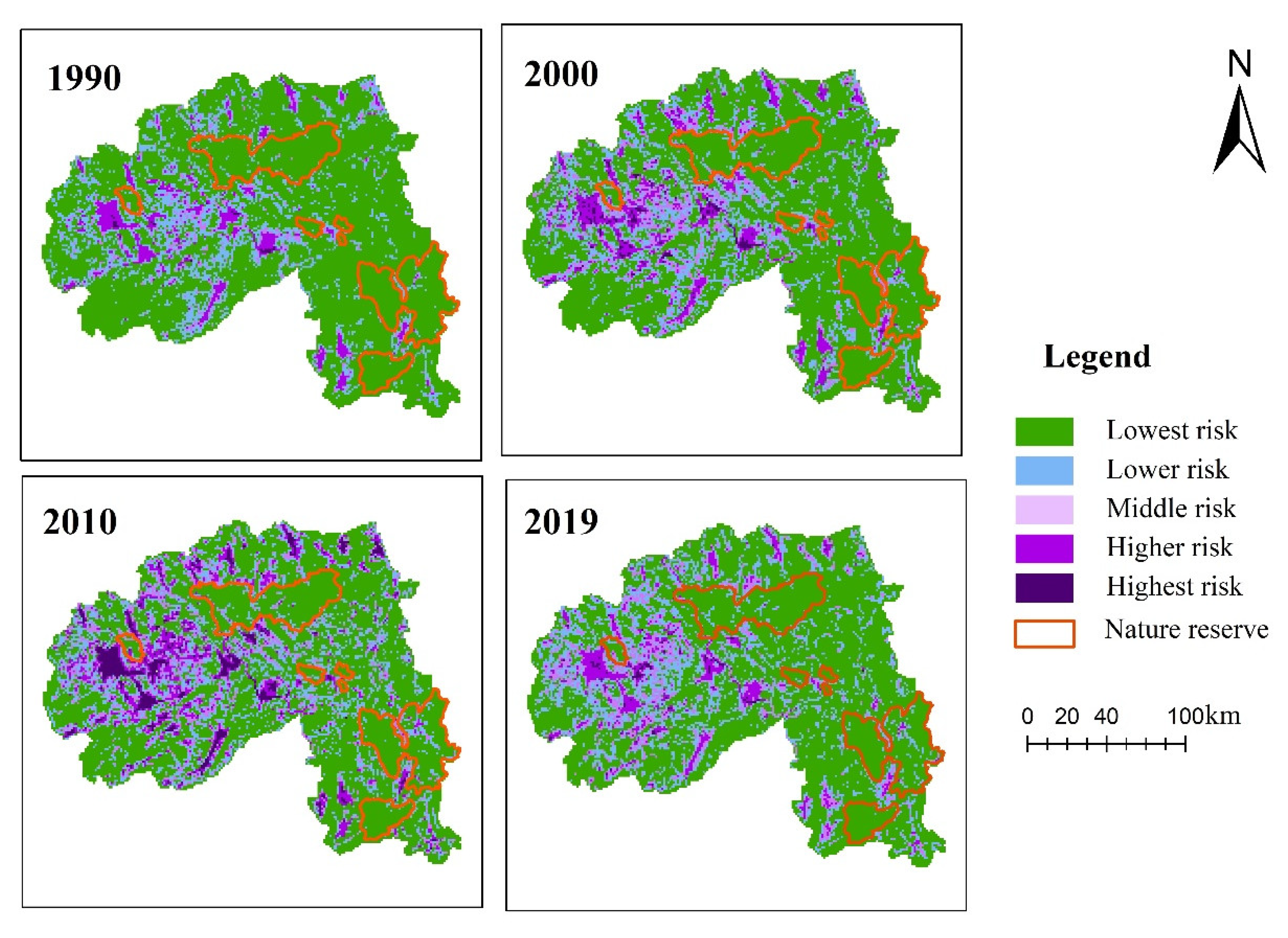
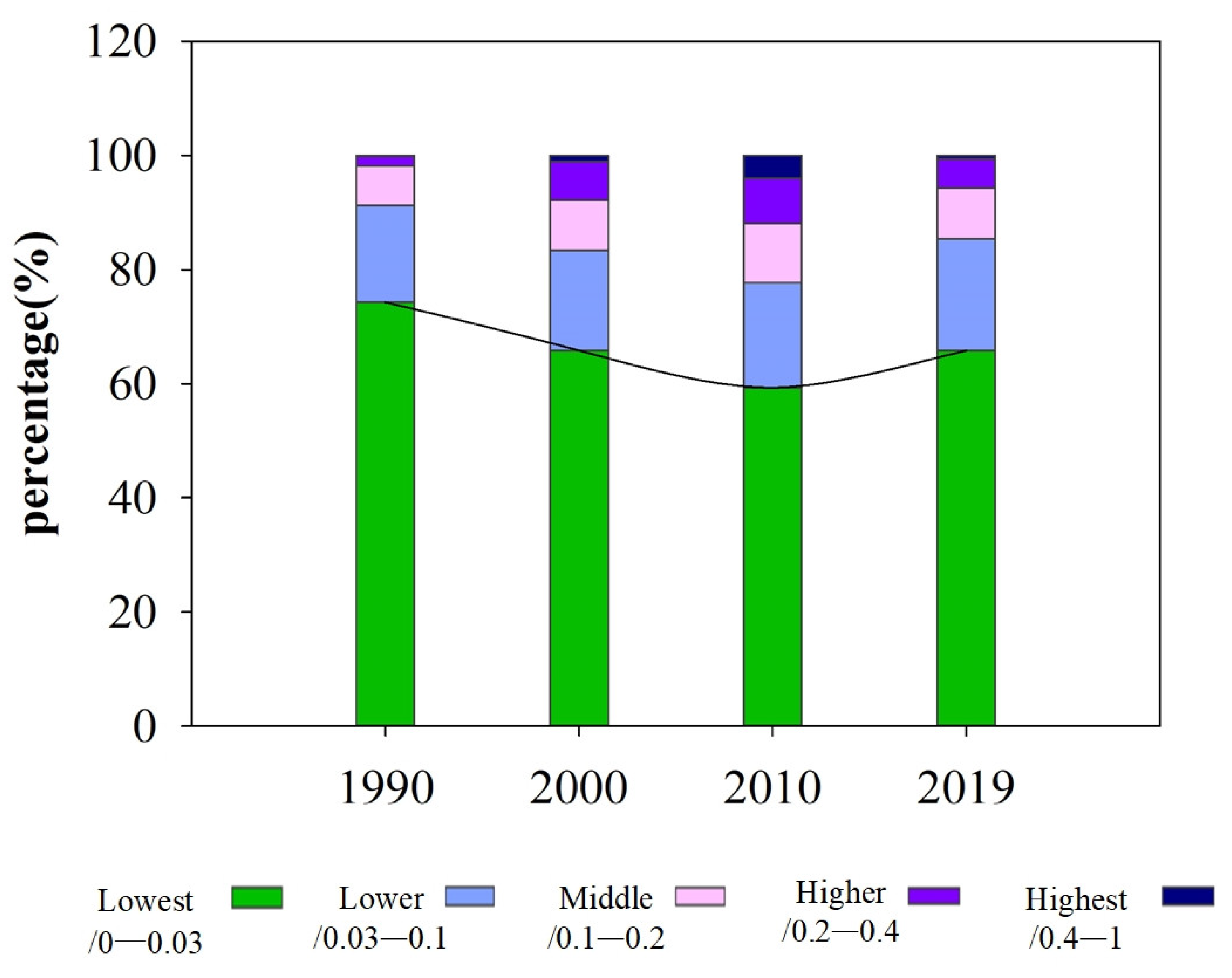


| Year | Cropland | Forest | Shrub | Impervious | Water | Others | |
|---|---|---|---|---|---|---|---|
| 1990 | Pct. (%) | 9.05 | 89.81 | 0.60 | 0.02 | 0.18 | 0.33 |
| 2000 | Pct. (%) | 10.18 | 89.24 | 0.19 | 0.04 | 0.19 | 0.16 |
| 2010 | Pct. (%) | 9.59 | 89.55 | 0.35 | 0.08 | 0.22 | 0.21 |
| 2019 | Pct. (%) | 10.60 | 88.39 | 0.39 | 0.21 | 0.23 | 0.18 |
| Year | Land Type/km2 | Cropland | Forest | Shrub | Impervious | Water | Others |
|---|---|---|---|---|---|---|---|
| 1990 to 2000 | Cropland | 1293.46 | 407.79 | 3.10 | 2.97 | 3.75 | 12.17 |
| Forest | 597.94 | 16,486.31 | 13.43 | 0.02 | 0.11 | 1.42 | |
| Shrub | 25.11 | 61.90 | 18.36 | 0.00 | 8.32 | 0.62 | |
| Impervious | 0.01 | 0.00 | 0.00 | 4.06 | 0.20 | 0.01 | |
| Water | 2.83 | 1.15 | 0.00 | 0.06 | 30.21 | 0.41 | |
| Others | 18.12 | 24.95 | 1.60 | 0.28 | 2.10 | 15.54 | |
| 2000 to 2010 | Cropland | 1373.41 | 522.16 | 8.71 | 6.30 | 7.20 | 19.69 |
| Forest | 434.20 | 16,499.93 | 43.92 | 0.34 | 0.20 | 3.50 | |
| Shrub | 6.60 | 15.36 | 14.02 | 0.00 | 0.00 | 0.51 | |
| Impervious | 0.01 | 0.00 | 0.00 | 6.90 | 0.47 | 0.00 | |
| Water | 2.35 | 1.74 | 0.00 | 0.41 | 31.66 | 0.20 | |
| Others | 7.82 | 2.77 | 0.66 | 1.56 | 1.92 | 15.41 | |
| 2010 to 2019 | Cropland | 1351.25 | 427.20 | 8.55 | 15.65 | 4.61 | 17.12 |
| Forest | 636.03 | 16,357.61 | 44.10 | 1.72 | 0.20 | 2.28 | |
| Shrub | 14.79 | 31.20 | 20.91 | 8.33 | 0.00 | 0.41 | |
| Impervious | 0.01 | 0.00 | 0.00 | 14.90 | 0.62 | 0.00 | |
| Water | 2.74 | 0.31 | 0.00 | 0.12 | 38.25 | 0.04 | |
| Others | 11.48 | 4.88 | 0.33 | 6.75 | 0.90 | 14.98 | |
| 1990 to 2019 | Cropland | 1102.95 | 555.70 | 4.45 | 29.85 | 10.57 | 19.69 |
| Forest | 859.93 | 16,169.67 | 55.97 | 2.45 | 1.10 | 10.10 | |
| Shrub | 28.02 | 66.06 | 11.36 | 0.02 | 0.03 | 0.50 | |
| Impervious | 0.06 | 0.00 | 0.00 | 3.50 | 0.71 | 0.00 | |
| Water | 4.29 | 2.71 | 0.00 | 0.31 | 27.29 | 0.05 | |
| Others | 21.05 | 27.04 | 2.12 | 3.01 | 4.87 | 4.49 | |
| Total | 2016.30 | 16,821.18 | 73.90 | 39.14 | 44.57 | 34.83 | |
| Variation | 293.09 | −278.04 | −32.09 | 34.87 | 9.92 | −27.75 |
| ERI Grade | Lowest/ (0–0.03) | Lower/ (0.03–0.1) | Middle/ (0.1–0.2) | Higher/ (0.2–0.4) | Highest/ (0.4–1) | |
|---|---|---|---|---|---|---|
| 1990 | Area (km²) | 14,139.52 | 3230.73 | 1321.91 | 319.48 | 30.51 |
| Pct. (%) | 74.27 | 16.97 | 6.94 | 1.68 | 0.16 | |
| 2000 | Area (km²) | 12,530.76 | 3348.30 | 1672.80 | 1277.93 | 208.20 |
| Pct. (%) | 65.82 | 17.59 | 8.79 | 6.71 | 1.09 | |
| 2010 | Area (km²) | 11,286.93 | 3509.83 | 1982.41 | 1491.52 | 767.30 |
| Pct. (%) | 59.29 | 18.44 | 10.41 | 7.83 | 4.03 | |
| 2019 | Area (km²) | 12,530.76 | 3718.04 | 1706.90 | 981.78 | 109.49 |
| Pct. (%) | 65.82 | 19.53 | 8.97 | 5.16 | 0.58 | |
| Years | Obvious Decrease | Slight Decrease | Invariability | Slight Increase | Obvious Increase | |||||
|---|---|---|---|---|---|---|---|---|---|---|
| 1990 to 2000 | change level | ↓4 | ↓3 | ↓2 | ↓1 | 0 | ↑1 | ↑2 | ↑3 | ↑4 |
| area/km2 | 0.00 | 3.59 | 52.05 | 630.90 | 13,798.15 | 3977.46 | 541.16 | 35.00 | 0.00 | |
| change/km2 | 3.59 | 682.95 | 13,798.15 | 4518.61 | 35.00 | |||||
| percentage/% | 0.02% | 3.59% | 72.48% | 23.73% | 0.18% | |||||
| 2000 to 2010 | change level | ↓4 | ↓3 | ↓2 | ↓1 | 0 | ↑1 | ↑2 | ↑3 | ↑4 |
| area/km2 | 0.00 | 17.95 | 116.67 | 938.72 | 13,696.73 | 3714.51 | 497.18 | 51.15 | 5.38 | |
| change/km2 | 17.95 | 1055.39 | 13,696.73 | 4211.69 | 56.54 | |||||
| percentage/% | 0.09% | 5.54% | 71.95% | 22.12% | 0.30% | |||||
| 2010 to 2019 | change level | ↓4 | ↓3 | ↓2 | ↓1 | 0 | ↑1 | ↑2 | ↑3 | ↑4 |
| area/km2 | 3.59 | 99.62 | 578.85 | 4160.53 | 13,212.12 | 883.08 | 93.33 | 6.28 | 0.90 | |
| change/km2 | 103.20 | 4739.38 | 13,212.12 | 976.42 | 7.18 | |||||
| percentage/% | 0.54% | 24.89% | 69.40% | 5.13% | 0.04% | |||||
Publisher’s Note: MDPI stays neutral with regard to jurisdictional claims in published maps and institutional affiliations. |
© 2022 by the authors. Licensee MDPI, Basel, Switzerland. This article is an open access article distributed under the terms and conditions of the Creative Commons Attribution (CC BY) license (https://creativecommons.org/licenses/by/4.0/).
Share and Cite
Liu, Y.; Xu, W.; Hong, Z.; Wang, L.; Ou, G.; Lu, N. Assessment of Spatial-Temporal Changes of Landscape Ecological Risk in Xishuangbanna, China from 1990 to 2019. Sustainability 2022, 14, 10645. https://doi.org/10.3390/su141710645
Liu Y, Xu W, Hong Z, Wang L, Ou G, Lu N. Assessment of Spatial-Temporal Changes of Landscape Ecological Risk in Xishuangbanna, China from 1990 to 2019. Sustainability. 2022; 14(17):10645. https://doi.org/10.3390/su141710645
Chicago/Turabian StyleLiu, Yun, Weiheng Xu, Zehu Hong, Leiguang Wang, Guanglong Ou, and Ning Lu. 2022. "Assessment of Spatial-Temporal Changes of Landscape Ecological Risk in Xishuangbanna, China from 1990 to 2019" Sustainability 14, no. 17: 10645. https://doi.org/10.3390/su141710645







